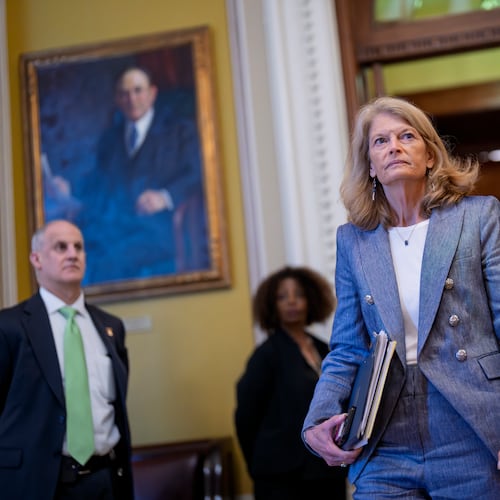Alexander Hamilton Stephens, the vice president of the Confederacy, declared shortly after secession in 1861 that the new nation’s “corner-stone rests upon the great truth, that the negro is not equal to the white man.”
Stephens is also one of two Georgians the state chose to honor with a statue in the U.S. Capitol. Longtime civil rights leader and U.S. Rep. John Lewis said this week that Stephens' marble visage, which has stood for 88 years, no longer belongs in the tourist-clogged National Statuary Hall.
As the nation debates the placement of Confederate battle flags at statehouses and on license plates following the racially motivated slayings of nine black churchgoers last week in Charleston, S.C., statues could be the next frontier.
The Congressional Black Caucus discussed the Confederate figures who line the Capitol at its meeting Wednesday and could soon come up with a list of statues its members want removed.
“It’s the beginning of a movement that will help us move toward the realization that we’re one people, we’re one nation and we have to be sensitive to our own history,” Lewis, an Atlanta Democrat, told The Atlanta Journal-Constitution.
Each state pays to have two statues of famous natives placed somewhere in the Capitol, a system laid out in an 1864 law. Georgia's other honoree, Crawford W. Long, was a 19th century physician who pioneered the use of ether in surgery, a noncontroversial pick. In 1982, Congress singled out a third Georgian, Martin Luther King Jr., to be honored with a bust.
States can — and do — change their statues, but it’s not up to their congressional delegations.
According to the Architect of the Capitol, a state legislature and governor must approve the request for a new statue. It must be of a deceased person "illustrious for historic renown or for distinguished civic or military services."
The state must also pay for the new statue, including transportation and removal costs for the old one. All of it is subject to approval by the Library of Congress and the Architect of the Capitol, the entity that oversees the Capitol grounds.
Lewis’ view on Stephens and other honored Confederates is not universal, even among Georgia’s black caucus members.
U.S. Rep. David Scott, an Atlanta Democrat, said the debate should remain focused on the Confederate battle flag because of its use as a symbol of white supremacy:
“If we went around here trying to remove every statue of everybody connected with the South and slavery and all that, hell, we’d be moving George Washington’s statue,” Scott said. “He owned slaves. Thomas Jefferson owned slaves. They all owned slaves. …
“Nobody took a statue and made it a symbol of racism. It’s the flag.”
U.S. Rep. Hank Johnson, a Lithonia Democrat, said he did not know who Stephens was, nor had he ever noticed the statue.
“As far as monuments and street names and building names, where do you stop?” he said. “Where does it all lead to?”
Lewis said his problem is to have such statues in a place that is supposed to represent unity. “Some of the statues that are in the Capitol, they could be put in museums and different places,” Lewis said.
The veteran of the civil rights movement is not calling for expunging all remnants of that era. For example, Lewis recently said that the Edmund Pettus Bridge in Selma, Ala., where Lewis and others were beaten in the 1965 "Bloody Sunday" march, should keep its name, even though Pettus was a Confederate general and member of the Ku Klux Klan.
Georgia Republican U.S. Sen. Johnny Isakson also drew a distinction between a flag and a statue.
“I think there’s a world of difference in a human life in totality and a battle flag that was used in hate,” Isakson said. “So I think you have to be very careful when you start talking about human beings because you’ve got to take care of those human beings for what they contributed in their lifetime and the totality of their life, not an inanimate object like a flag that got abused.”
Stephens, a Crawfordville native, was orphaned as a teenager but rose to serve in Georgia’s Legislature and the Congress as a Whig, a Democrat and a Constitutional Unionist. After the state seceded, he was selected as the vice president of the Confederacy, even though he had been a staunch Unionist.
In March 1861, Stephens delivered what is known as the “Cornerstone Speech” in Savannah, laying out the reasons for secession.
"Our new government is founded upon exactly the opposite idea; its foundations are laid, its corner-stone rests upon the great truth, that the negro is not equal to the white man; that slavery — subordination to the superior race — is his natural and normal condition," Stephens said, according to a newspaper account.
After the war, Stephens was elected to the U.S. Senate but denied a seat because Georgia had not yet been readmitted to the Union. He later returned to the U.S. House, then was elected governor, but he served only four months before his 1883 death.
Famously frail and sickly, he is sculpted as seated in a chair. Stephens is not well known, though he did have a moment of fame in the Stephen Spielberg film "Lincoln," in which he is depicted trying to cut a deal with Abraham Lincoln to end the Civil War.
Stephens holds a fairly prominent spot in Statuary Hall. Lewis said it bothers him, particularly, to explain the statue to schoolchildren as he gives tours.
The inscription on the Stephens statue is a quote apparently attributed to him: “I am afraid of nothing on the earth, above the earth, beneath the earth, except to do wrong.”
About the Author
Keep Reading
The Latest
Featured


